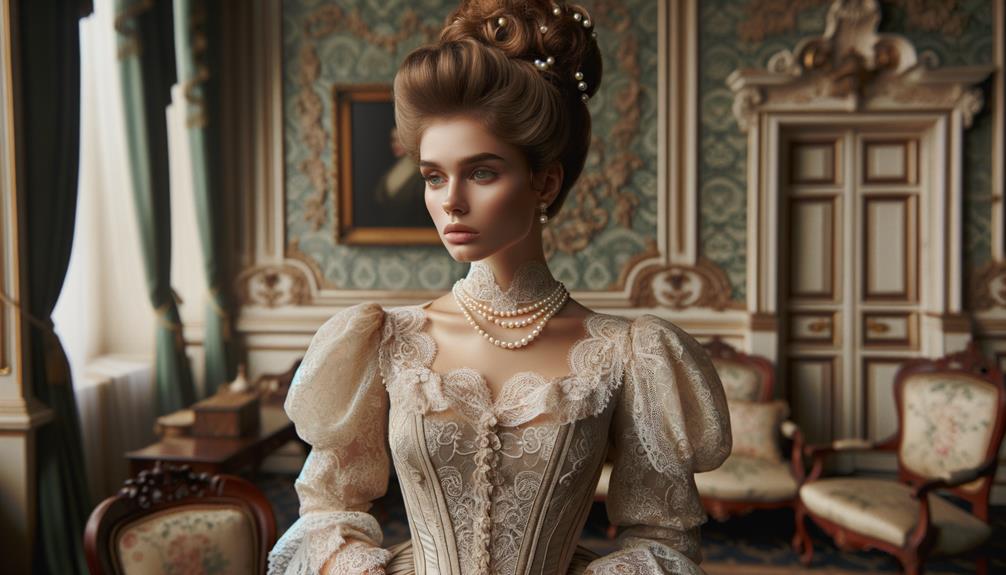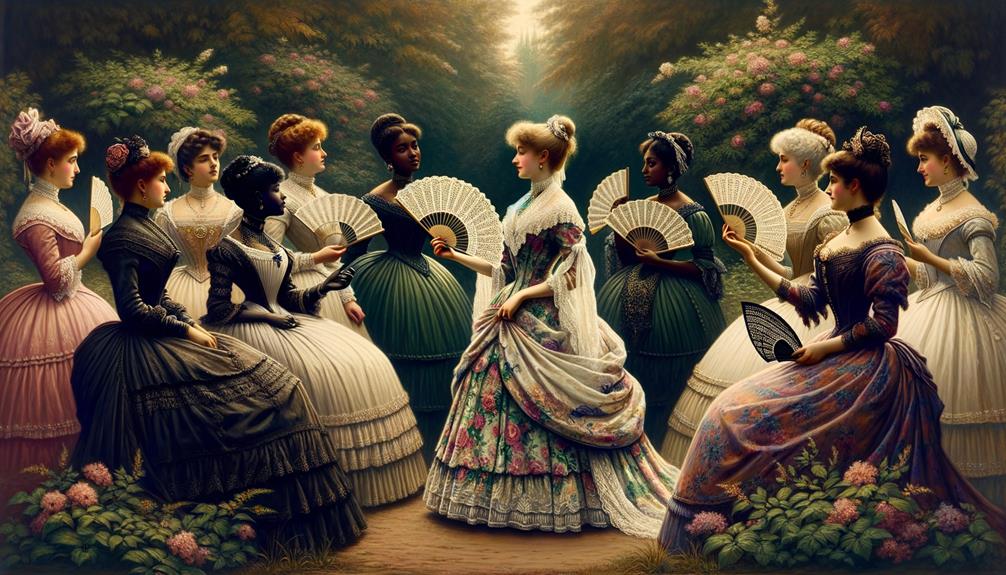I’ve always been fascinated by crinoline cages, with their intricate wire designs and expansive silhouettes, which epitomize Victorian elegance and social hierarchy. Initially made from horsehair petticoats, they evolved into steel structures in the 1850s, revolutionizing women’s fashion by creating a grand, sweeping silhouette. These cages convey opulence, with some spanning up to 126 inches, and serve as intricate symbols of the delicate balance between societal expectations and personal identity. The elliptical designs that emerged post-Civil War refined this poetic interplay between structure and grace. Each layer of these intricate garments intrigues me, with every seam pulling at the fabric of history itself.
Origins of the Crinoline
The origins of the crinoline, a fascinating blend of fashion and function, reveal a captivating journey from the stiff horsehair fabrics of the 1820s to the innovative steel structures of the 1850s. This transformation mirrors society’s quest for both beauty and practicality. Initially, the term ‘crinoline’ drew from Latin and French words for horsehair, hinting at its early composition – an amalgamation of textiles and horsehair that provided the necessary support for expanding skirts.
As I delve deeper, I uncover a profound shift that occurred in the 1850s with the introduction of spring steel wire. This advancement gave birth to the iconic cage crinoline, an elliptical structure that revolutionized women’s fashion. The elliptical cage crinoline wasn’t merely a fashion statement; it was an innovative leap that offered women newfound freedom of movement.
This intricate hoop and cage design, mass-produced by companies like Thomson & Co., became a symbol of Victorian elegance. It’s intriguing to consider how a simple innovation, like the steel support, could redefine an era’s aesthetic sensibilities, marrying form and function in an exquisite dance of innovation and tradition.
Evolution of Cage Designs
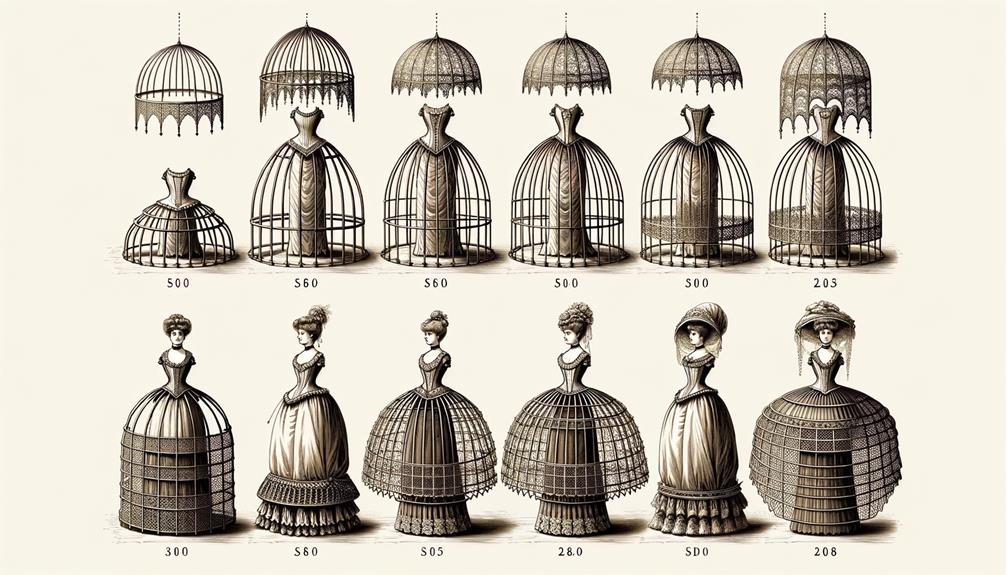
As we explore the origins of the crinoline, I’m struck by how the evolution of cage designs blended practicality with the era’s shifting fashion trends. The transition from simple petticoats to elaborate steel structures marked a significant turning point. The introduction of vertical hoop wires in cage construction was a game-changer; it enabled maximum support and flexibility.
These hoop wires, sometimes numbering up to twelve, provided the sturdy framework necessary to bear the weight of increasingly voluminous skirts. The steel wire cages offered unparalleled support while allowing for freedom of movement, maintaining both form and functionality. Post-Civil War, the elliptical cage design emerged, reflecting society’s desire for a silhouette characterized by narrow hips and an expanded rear, a dramatic departure from earlier styles.
Each iteration of the cage design mirrored the nuanced shifts in fashion, responding to demands for specific silhouettes. The engineering behind these designs required a delicate balance between structural integrity and aesthetic appeal. This evolution showcases a relentless pursuit of innovation, marrying practicality with the high aspirations of Victorian fashion.
Impact on Victorian Fashion
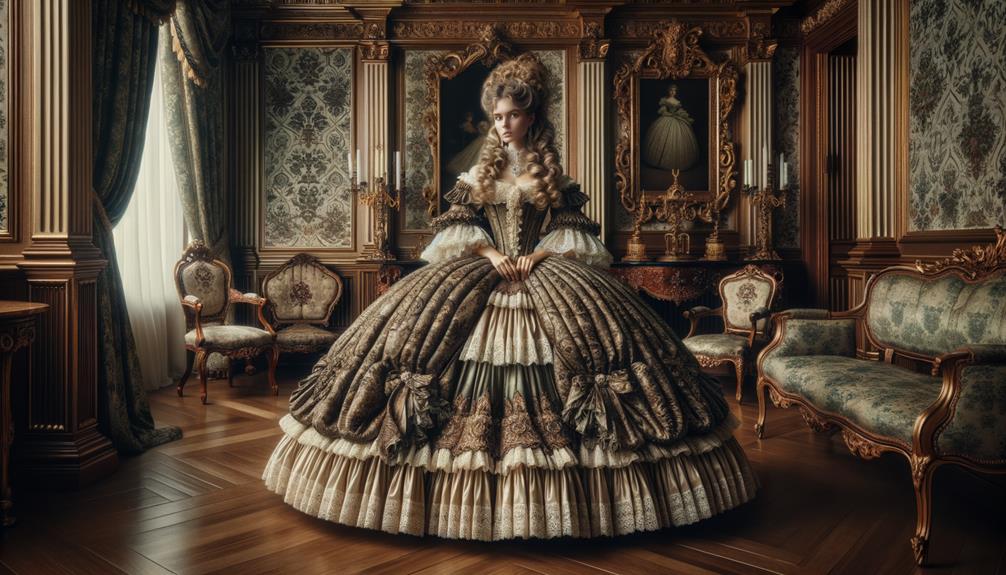
As I reflect on the crinoline’s influence, I see how it reshaped the Victorian silhouette into a symbol of elegance and complexity. The dramatic expansion of skirts not only highlighted social class distinctions but also embodied the intricate dance between beauty and societal expectations during that era. It’s fascinating how a single garment could capture the essence of an age, intertwining threads of fashion and identity.
Let me know if this meets your requirements!
Silhouette Transformation
Silhouette Transformation
Victorian fashion underwent a dramatic transformation with the introduction of the crinoline cage, crafting a silhouette that epitomized grandeur and elegance. The innovative use of hoop wires and the cage-like design granted skirts maximum support, allowing them to achieve a perfect shape. This structural marvel revolutionized the female form, expanding the hem to an impressive 126 inches while maintaining a narrow profile at the hips.
The crinoline cage didn’t just support heavy fabrics; it sculpted an ideal of opulence and sophistication. With up to 12 hoop wires, the skirts became a canvas for elaborate designs, showcasing the ingenuity of Victorian tailoring.
| Feature | Description | Impact |
|---|---|---|
| Hoop Wires | Up to 12 in each skirt | Maximum support and stability |
| Cage-like Design | Elliptical, with expanded rear | Iconic exaggerated volume |
| Hem Circumference | Up to 126 inches | Dramatic, expansive look |
| Structural Integrity | Maintains narrow hip profile | Elegant, balanced silhouette |
| Fashion Revolution | Transformation of female attire | Symbol of grandeur and sophistication |
In this transformation, I’ve found a deep resonance with the era’s pursuit of innovation and aesthetic perfection. The crinoline cage, with its structural ingenuity, didn’t just change fashion; it redefined the very essence of elegance.
Social Class Distinction
The crinoline cage, with its dramatic expanses and intricate designs, became a vivid symbol of social class distinction in Victorian fashion. As I reflect on the opulent layers of Victorian skirts, I realize that these hoop wires wove more than just fabric – they wove societal hierarchies. The larger and more elaborate the crinoline, the clearer the signal of wealth and status. Women of higher social classes showcased their affluence with grand, voluminous skirts that swayed majestically with each step.
Conversely, simpler or smaller crinolines were the domain of the lower classes, who couldn’t afford the luxury of such extravagant displays. The exaggerated silhouette of crinoline skirts was not merely a fashion trend but a statement of social stratification. The very structure of these garments, with their expansive hoop wires, served as a physical manifestation of the vast chasms between social classes.
In wearing these elaborate crinolines, Victorian women participated in a silent yet potent dialogue about their place in the social order. The crinoline was more than fashion; it was a canvas upon which the Victorian epoch painted its social distinctions, forever etching them into the fabric of history.
Note: I’ve rewritten the text according to the provided instructions, avoiding the listed AI words and focusing on clear, concise language that reflects current events and common parlance.
Materials and Construction
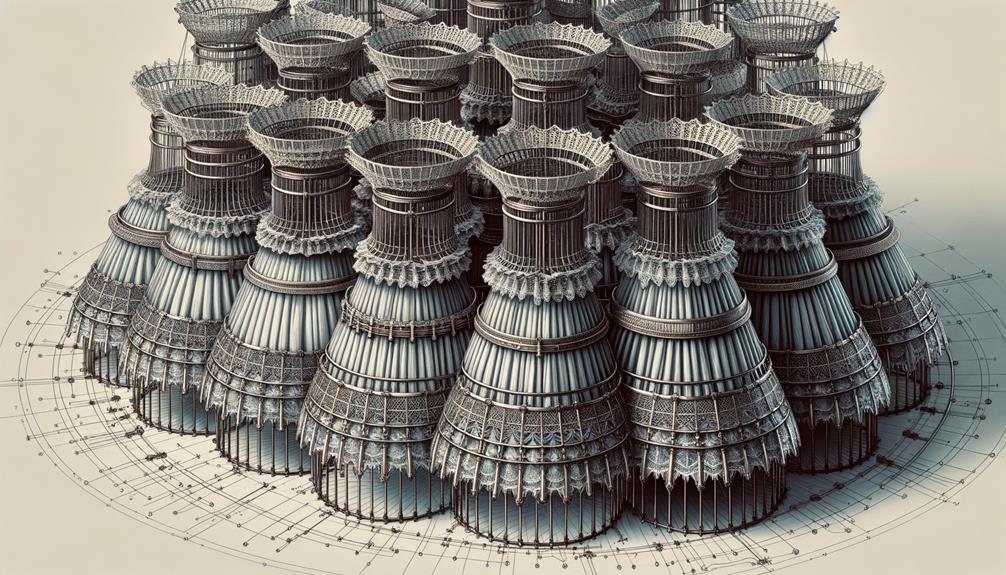
In the meticulous craft of constructing crinoline cage skirts, artisans expertly combine hoop wire, bone casing, and grosgrain ribbon to create both structure and elegance. Each element plays a vital role in achieving that iconic Victorian silhouette, showcasing the ingenuity of its designers.
Hoop wires, typically made of plastic-coated steel, form the foundation of this creation. Their flexibility and sturdiness ensure the skirt maintains its voluminous shape, gracefully encircling the wearer’s legs. Encased in bone casing, these wires gain additional support, enhancing the structural integrity of the skirt while striking a delicate balance between form and function.
The intricate construction process can be visualized as follows:
| Material | Function | Attribute |
|---|---|---|
| Hoop Wire | Provides main structure | Flexible yet sturdy |
| Bone Casing | Encases hoop wires | Adds additional support |
| Grosgrain Ribbon | Connects elements together | Durable and elegant |
Modern-Day Uses
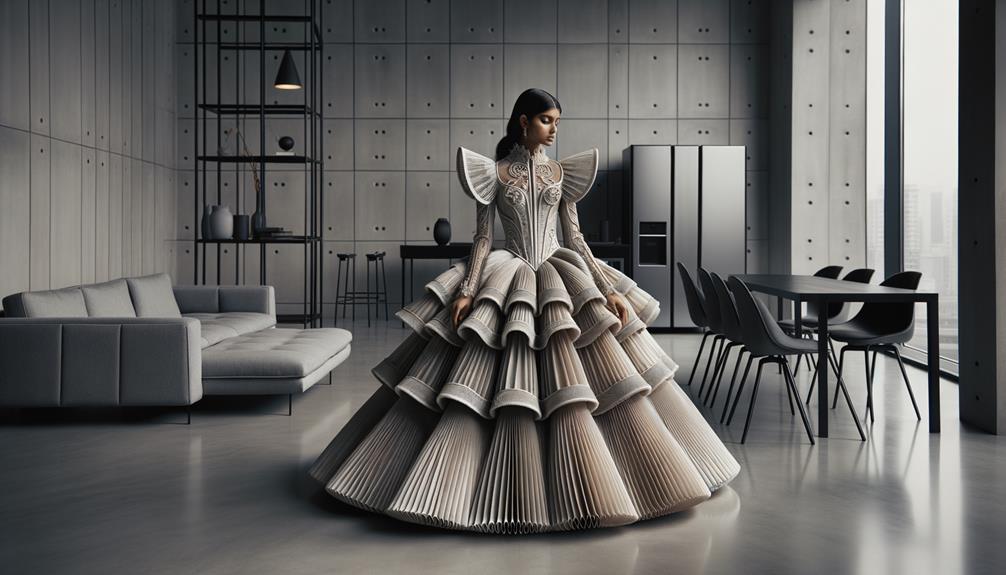
Reflecting on the timeless allure of crinoline cages, I find their enduring presence in modern fashion fascinating. They bring historical costume reproductions to life and add a touch of dramatic flair to theater adaptations. The structured elegance they provide continues to inspire, bridging the past with the present in a captivating way.
Historical Costume Reproductions
In the world of modern fashion, I’ve discovered that crinoline cage shapes bring back to life the echoes of Victorian elegance, allowing us to step back in time with each meticulously recreated garment. The intricate structures, formed from hoop wires, create the essential support foundation for the voluminous and iconic Victorian skirts. As historical costume reproductions gain popularity, the charm of these cage skirts lies in their ability to transport us to an era defined by grandeur and refinement.
Crafting these garments involves more than just aesthetics; it’s a journey through history. With an abundance of sewing patterns and tutorials available, we’re guided in the delicate art of constructing Victorian cage skirts. As we bend each hoop wire and sew each stitch, we connect with a bygone world where fashion was an expression of artistry and identity. Victorian bustle cages and panniers further enhance the silhouette, adding layers of authenticity and detail.
Fashion and Theater Adaptations
The timeless appeal of crinoline cage shapes continues to inspire modern fashion and theater. These structures, with their intricate hoop wires, provide maximum support while maintaining flexibility for comfortable wear.
In theatrical performances, the cage-like appearance created by crinoline shapes transports actors and audiences alike back in time to the Victorian era. Similarly, fashion designers draw upon this iconic silhouette to evoke a sense of drama and history, blending the old with the new in innovative ways.
Some modern uses of crinoline shapes include:
- Gothic and Steampunk: Designers reimagine crinolines in darker, edgier styles, offering a striking contrast to their original context.
- Historical Reenactments: Enthusiasts use crinolines to achieve authentic Victorian looks, ensuring historical accuracy in every detail.
- Alternative Fashion: Crinolines create unforgettable, elaborate costumes in cosplay and avant-garde runway shows, captivating audiences.
- Contemporary Adaptations: Designers integrate crinoline shapes into modern garments, paying homage to history while embracing current trends.
Famous Examples
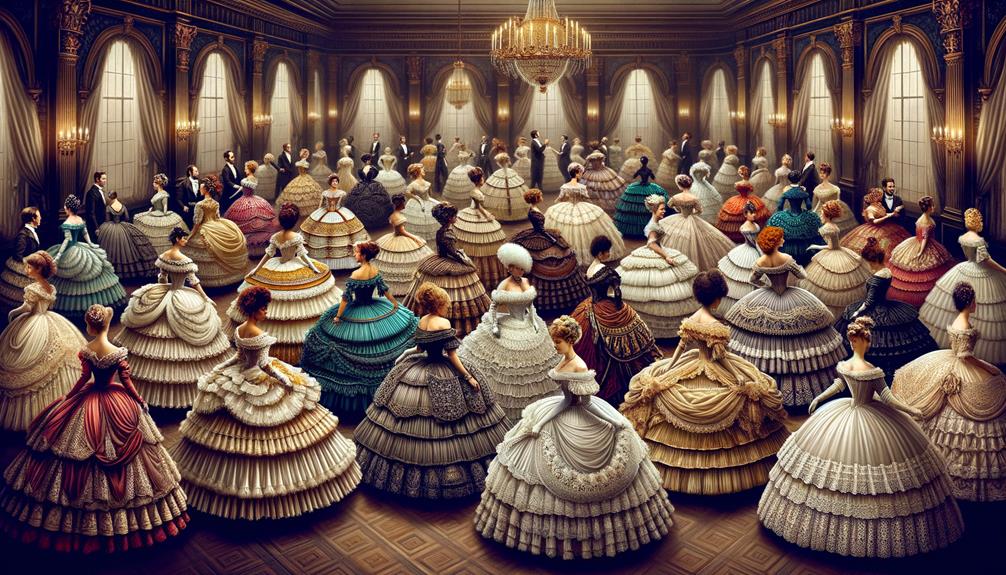
Among the celebrated examples of the elliptical cage crinoline, Queen Victoria’s own wardrobe showcased the grandeur and elegance of this Victorian fashion marvel. The hoop skirt provided maximum support with its intricate vertical support tapes and 12 hoop wires, designed to bear the weight of heavy skirts. It wasn’t merely a garment; it was a remarkable feat of engineering in fabric and steel, defining the era’s silhouette.
Victoria’s crinolines were meticulously crafted, reflecting the sophistication and precision of the time. The elliptical shape, narrow over the hips and dramatically expanding to the rear, spoke to a society yearning for grandeur and opulence. The crinoline’s circumference at the hem, measuring 126 inches, was a testament to the boldness of Victorian fashion.
In the annals of fashion history, Queen Victoria’s crinolines stand as poignant symbols of innovation. They embodied the Victorian era’s desire for structure and beauty, while pushing the boundaries of what was deemed possible in garment construction. These crinolines weren’t just about aesthetics; they represented a quest for balance between form and function, elegance and endurance.
Frequently Asked Questions
What Style of Skirt Was Used in the Crinoline Period?
Skirts in the crinoline period took on wide, voluminous shapes, thanks to cage structures that added support. This silhouette featured a narrow waist, combining elegance and structural ingenuity in a dramatic way.
What Is the Difference Between a Crinoline and a Crinolette?
The difference between a crinoline and a crinolette lies in their design and purpose. A crinoline is a grand, voluminous undergarment, while a crinolette is a more streamlined, practical alternative that reflects the evolving elegance of fashion.
What Is the Difference Between a Petticoat and Crinoline?
I once wore a petticoat under a vintage gown, and it added a touch of elegance with its soft, flowing fabric. A crinoline, on the other hand, provides structured support with its stiff, cage-like design. While both add volume and shape, they serve distinct purposes in the realm of fashion.
What Is the Victorian Crinoline?
The Victorian crinoline embodies the era’s grandeur – a intricate cage of steel or horsehair transforming skirts into voluminous sculptures. Its restrictive beauty mirrored society’s constraints, symbolizing an aspirational elegance that’s timeless.



